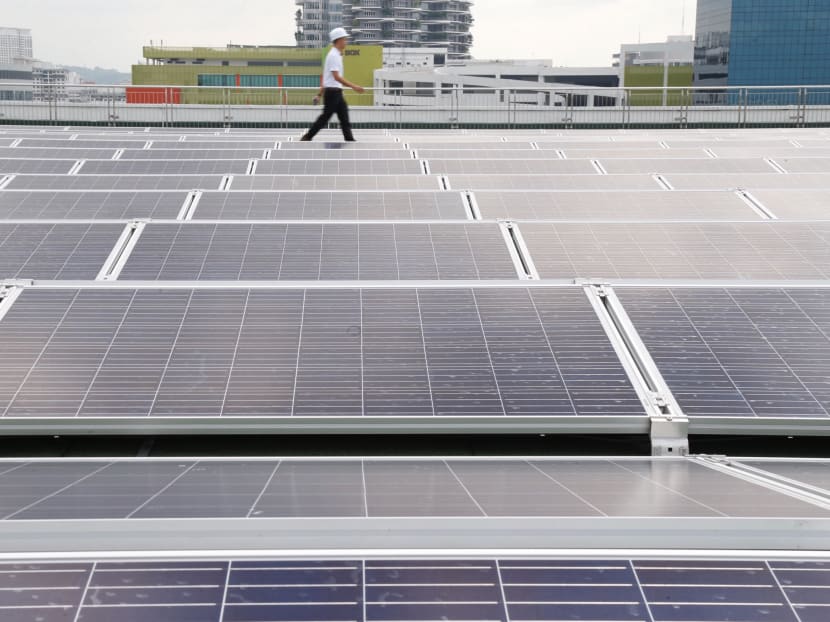New solar targets ‘good start’, but unlikely to have significant impact, say experts

According to this year’s energy consumption statistics from the Energy Market Authority, solar power currently meets less than 1 per cent of the country's energy demand.
SINGAPORE – A recent announcement to ramp up Singapore’s solar energy production by 2030 is a step in the right direction, but the new targets are still too low to have much of an impact in the fight against climate change or on consumers’ electricity bills, experts said.
On Tuesday (Oct 29), Minister for Trade and Industry Chan Chun Sing announced that Singapore now aims to produce at least 2 gigawatt-peak (GWp) of solar energy by 2030.
This is more than five times the target that the Republic previously set, of producing 350 megawatt-peak (MWp) of solar energy by 2020, which it is on track to meet, he said.
Scientists have repeatedly warned that carbon emissions need to be drastically reduced by 2050 to keep global warming below 2°C — failing which there will be disastrous effects on global economies and societies — and one way to do that is through the use of more green energy such as solar power.
Professor Anthony Owen, a principal fellow at the National University of Singapore's Energy Studies Institute, said Tuesday’s announcement is a good step towards greening the Republic’s energy sector, but it will likely have “very little” significance for the climate as the solar targets are “so small by global standards”.
“However, in principle it’s a good start,” said Prof Owen, whose research interests include environmental impact of alternative power generation technologies.
Agreeing, Professor Subodh Mhaisalkar, executive director of Nanyang Technological University’s Energy Research Institute, said that 2 GWp of solar energy represents only a small percentage of Singapore’s electricity demand.
According to this year’s energy consumption statistics from the Energy Market Authority, solar power currently meets less than 1 per cent of the country's energy demand.
The new targets will represent about 4 per cent of Singapore’s current total electricity demand.
Added Prof Subodh: “It is unlikely, even by 2050, that we will be in a situation where we have more electricity (generated) by solar than what we need.”
MINOR PRICE FALLS
The addition of more green energy to Singapore’s power grid may reduce the demand for electricity generated by non-renewable sources such as natural gas, but experts warned that this might not necessarily lead to drastic reductions in household electricity bills.
Solar is one of the cheapest sources of electricity today, noted Ms Kohe Hasan, a specialist energy and commodities lawyer at law firm Reed Smith.
For example, a new 60-megawatt solar farm project in Cambodia has announced a tariff rate of 3.877 US cents (5.283 Singapore cents) per kilowatt hour, the lowest power purchase tariff recorded in Southeast Asia, she said.
“It is hoped that in increasing (solar’s) contribution towards Singapore’s energy mix from less than 1 per cent to about 4 per cent, there will be a concomitant reduction in the tariff rate,” she said.
Prof Owen, however, expressed his doubts that this would happen.
He acknowledged that rooftop solar “effectively reduces market demand” for electricity during daylight hours, which consequently means that wholesale price of electricity should fall at these times.
But, he also pointed out that there are various factors that affect the operation and price-bidding behaviour of natural gas facilities.
“I would expect, on balance, that any retail price falls would be minor,” he said.
GOING BEYOND SOLAR
Singapore is working on ways to maximise the number of solar panels that can be deployed here, but space will remain an issue in this land-scarce country, experts noted.
One solution Mr Chan alluded to in his speech on Tuesday is the Asean Power Grid, an initiative conceptualised in the late 1990s that could see greater electricity integration in the region using renewable energy.
“Today in Southeast Asia, some countries have an abundance of hydro and other renewables,” said Mr Chan. “If we can connect the regional grid, it will provide greater resilience and stability for the entire system.”
Ms Kohe said that this is a feasible solution as cross-border power grid connections “could relieve burdens” related to excess power generation capacity.
However, she stressed that this is dependent on participating parties agreeing to support one another and work together to deal with technical issues, such as synchronising the various countries’ respective grids.
She added: “(The Asean Power Grid) offers the dual benefits of stronger energy and economic ties among member states, and the expansion of Asean’s influence in the global economy and environment.”
Meanwhile, Prof Subodh believes that a better alternative would be a future where solar energy is used to contribute to the production of hydrogen.
He said that hydrogen is the “ultimate clean fuel”, especially if it is “green hydrogen” generated from renewable energy sources that have zero carbon footprint.
Hydrogen itself, he said, produces water as a by-product when it is burnt.
Mixing hydrogen with natural gas would require little physical infrastructure changes, and it will also “burn a lot cleaner” than just natural gas alone.
He added that safety should not be something to be concerned about if a dedicated hydrogen power plant is ever built in the future. Prof Subodh explained that unlike natural gas, hydrogen is not combustible on its own.
“If we can handle LNG (liquid natural gas), we can handle hydrogen,” he said.








